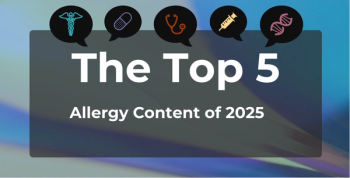
Older EoE Patients More Likely to Respond to Topical Corticosteroids, Study Finds
Recent clinical trials have excluded older patients with eosinophilic esophagitis (EoE) from participating; however, patients aged 65 years and older are more likely to respond to topical corticosteroids than their younger counterparts.
Patients with eosinophilic esophagitis (
The researchers used a retrospective cohort study using the University of North Carolina EoE Clinicopathologic database. Patients were included if they had documented tCS treatment and a follow-up endoscopy with biopsy.
All outcomes were assessed in 3 domains: histology, endoscopy, and symptoms. For histologic findings, post-treatment peak eosinophil counts were recorded and histologic response was < 15 eosinophils per high-power field (eos/hpf). For endoscopic findings, the EoE Endoscopic Reference Score (EREFS) and the endoscopic severity score (ESS) were used with higher scores indicating endoscopic severity.
Multivariate logistic regression models were utilized to identify the relationship between histologic response and age.
For this study, 467 newly diagnosed patients with EoE were included. The mean age was 29 years; 33% patients were under 18 years old and 3% were aged 65 years or older. The sample was primarily Caucasian (83%) and male (68%).
The mean (SD) age of diagnosis in the group younger than 65 years was 27.8 (17.0) vs 70.4 (4.4) in the older group. The symptom length prior to diagnosis was shorter in the < 65 years group: 8.4 (8.8) years vs 24.0 (16.1) years. The older patients had a significantly lower baseline EREFS score compared with the younger group: 2.4 (1.9) vs 4.2 (2.1).
The older and younger groups were both treated with similar tCS: budesonide was used in 75% and 68% of cases, respectively. The mean steroid dose was slightly higher in the older population but there was no difference in dose for those ≥ 65 years compared with the younger group (2107 [606] mcg vs 1936 [616]).
Symptomatic response was high in older and younger groups (100% vs 76%). Both groups had declines in post-treatment mean eosinophil counts: 25.0 (37.5) eos/hpf in the younger group and 5.5 (13.1) eos/hpf in the older group. The older group had more response at < 15 eos/hpf (57% vs 92%), ≤ 6 eos/hpf (50% vs 83%), and < 1 eos/hpf (29% vs 58%).
The 18- to 39-year-old age group had the lowest rate of histological response whereas the ≥ 65 years age group had the highest. The ≥ 65 years age group was associated with histological response at the < 15 eos/hpf threshold (aOR 8.48; 95% CI, 1.08-66.4).
"These findings would seem to refute the concept of purposely excluding older patients from therapeutic trials because of the concern for more strictures or more difficult to treat disease," the authors wrote.
Endoscopic severity improved after treatment in both groups but was more prominent in the younger population and not significant for the older group. The older group had lower post-treatment EREFS (2.3 [2.0] vs 0.9 [0.9]) but there was no different in ESS (1.8 [1.5] vs 1.2 [0.9]). There were 6 older patients who had long-term endoscopic follow-up an average of 49 months after post-induction.
There were limitations to this study. It was conducted at a single center and was retrospective, which may limit the generalizability of the findings. The number of older patients is small which makes the estimates imprecise. A non-validated symptom assessment was used, so symptoms should be treated with caution. Patients who lacked EREFS scores were assessed with ESS. Some of the older patients lacked long-term follow-up.
The researchers concluded that patients with EoE who are 65 years and older have a higher likelihood of responding to tCS treatment compared with younger patients.
“The older EoE patients should be studied more closely and included in future clinical trials to better understand their taxonomy amongst the EoE population,” the authors wrote.
Reference
Ketchem CJ, Thakkar KP, Xue A, et al. Older patients with eosinophilic esophagitis have high treatment response to topical steroids. Dig Liver Dis. 2022;54:477-482. doi:10.1016/j.dld.2021.10.004
Newsletter
Stay ahead of policy, cost, and value—subscribe to AJMC for expert insights at the intersection of clinical care and health economics.







































